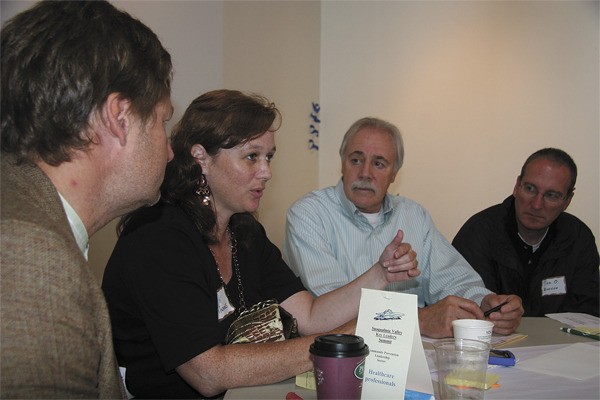Let’s suppose that five years from now, Valley residents have solved all of the problems that families go through in the community.
All neighborhoods are safe, and bullying and risky youth behavior are things of the past. Children stay involved in positive activities and have healthy relationships with their parents.
Envisioning that better future—then finding ways to get there—was the premise at the Snoqualmie Valley Key Leaders’ Summit, held Monday, Aug. 9, at Meadowbrook Farm.
Led by the Snoqualmei Valley Community Network, the forum aimed to empower business owners, educators, hospitals, youth advocates, counselors and other leaders to create a safe, nurturing community.
“There’s no blame or no shame,” said Kristy Trione, Snoqualmie Valley Community Network facilitator. “We’re all in this community together. We’re all responsible and yet not one of us can be responsible alone.”
Forum attendees were asked to think about how they have improved local conditions already— for example, raising money for schools and parent-teacher associations, enforcingrules and boundaries and sponsoring drug and alcohol education programs.
Parent Leanne Christensen urged families to communicate when they see risky behavior.
“I told my girls if it’s a safety thing,” she said. “What if that child continues to make these bad choices and they get killed through an accident?”
Attendees were also asked to name a problem they see for children growing up in the Valley and find a hypothetical solution for it.
North Bend resident and parent Jan-Olav Johansson said that as children get older, they don’t have as any cultural, positive activities keeping them on a successful path.
“Therefore, our students that do extremely well in school also make poor choices,” he said.
Johansson added that the community does not do much to solve youth-related problems until something bad has happened.
“Strategies are mostly reactive,” he said. “It’s damage control.”
Johansson’s response is to urge leaders to speak to various sectors of the community on proactive approaches.
“Five years from now, we’re going to look at current programs and strategies and ask ‘Why are we reactive, when we know better and have things that actually work in our community?” he said.
“We’re doing things in isolation that other people in the community don’t know about,” added Kim Thomas, Sound Mental Health parent coordinator and peer counselor. She said solutions in one area might carry over to other areas.
Other solutions discussed Monday included mainstreaming the stigma of mental health, building mental health, drug and alcohol education into school curriculum, creating a Web site for children to find everyday activities in the Valley, easy transportation for youth activities and a youth-built community center.
A youth-led center project “gives them the sense of entitlement,” said Kim Arellano, president of Women in Business. “We hope to give them resources to become responsible contributors.”
• The Snoqualmie Valley Community Network is a special district authorized by the state to address population-based health behaviors. Learn more about the organization at www.snoqualmievalleycommunitynetwork.org.



